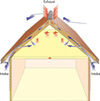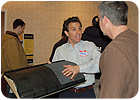Operation Ventilation
Air Vent Inc., a Dallas-based manufacturer of residential attic ventilation products, has been holding its Ask the Expert™ attic ventilation seminars for roofing professionals for nine years. According to Paul Scelsi, the seminar leader for Air Vent, the seminars take place across the country from January through March, and this year the seminar will be featured in the educational track at the International Roofing Expo in Las Vegas on March 8.

Air Vent Inc., a Dallas-based manufacturer of residential attic ventilation products, has been holding its Ask the Expert™ attic ventilation seminars for roofing professionals for nine years. According to Paul Scelsi, the seminar leader for Air Vent, the seminars take place across the country from January through March, and this year the seminar will be featured in the educational track at the International Roofing Expo in Las Vegas on March 8.
The two-hour technical seminar is designed to help roofing contractors, remodelers, builders, architects, designers, inspectors and distributors improve their understanding of how to specify and install an effective attic ventilation system. It covers the effects of improper attic ventilation, explores the types of vents that work best in specific applications, provides installation tips and explains how to calculate the proper amount of attic ventilation needed. The seminar includes a follow-up on ongoing case studies and a Q & A session.
“The question and answer session is popular because it allows us to address and answer any local concerns, challenges and questions that our audience faces daily in the field,” says Scelsi. “Our seminar allows roofing professionals to learn other common, avoidable mistakes and handy tips they can use on the job.” Roofing Contractor caught up with Scelsi in Livonia, Mich., as he conducted the second of two full-house sessions in the Detroit area in February. He explained that the seminars have continued to evolve over the years, making them an invaluable tool for contractors as well as the company. “Contractor feedback has helped Air Vent improve its products and its application recommendations,” says Scelsi. “It also helps us shape the content of next year’s seminars.”

Scelsi asserts that, when the building allows and the vents are properly sized, the use of continuous soffit vents for intake used in conjunction with a ridge vent for exhaust provides the most efficient and effective ventilation system. This option is aesthetically superior and is less labor intensive than other options, according to Scelsi. However, he points out that some houses preclude the use of this system, so in these cases, other options, such as vented drip edge, must be used for intake, while roof louvers (or can vents), wind turbines, or electric or solar-powered attic ventilators must be used for exhaust. The key, reminds Scelsi, is to make sure that the system is balanced. “The intake area should be equal to or exceed the exhaust area,” he states. Scelsi provides photos from actual case studies to document the mistakes some contractors make when it comes to ventilation, including insufficient intake ventilation. It’s not uncommon to find intake vents that are painted over, clogged with debris, or blocked by insulation, he notes, pointing out that he’s seen applications where there were no holes cut behind the vents at all.
Another common error involves mixing two different types of exhaust vents. “Air follows the path of least resistance, so if more than one type of exhaust vent is used - say, roof louvers and a ridge vent, for example - the stronger exhaust vent will pull from the other one, short-circuiting the system, potentially pulling in weather elements and leaving dead spots in the attic,” says Scelsi.
Another brochure includes a series of tips based on the Ask the Expert seminars. One of the most important tips is one of the most basic, says Scelsi - always inspect the attic if at all possible when estimating a roofing job. This allows the roofing professional to determine if any damage has resulted due to a lack of ventilation. Things to check include the size and location of existing intake and exhaust vents, and whether insulation or debris is clogging them. Any signs of moisture damage, mold or mildew should be documented and explained to the homeowner. “The contractor who inspects the attic separates himself from the competition,” concludes Scelsi.
Other tips include installing the ridge vent from end to end across the entire length of the roof to provide an attractive roofline. Scelsi also maintains that shingle-over ridge vents with exterior baffles, such as the company’s ShingleVent II and Peak Performer, provide the best performance. He notes that research has proven that external baffles not only prevent rain and snow from entering the attic, they deflect wind up and over the vent, creating an area of low pressure at the vent openings to pull air out of both sides of the vent.
For more information on Air Vent’s Ask the Expert seminars, visit www.airvent.com or call 800-373-0089, ext. 205. AIA, NARI, AIBD, ASHI, NAHI, A.I.I. and RCI members can earn continuing education credits by attending the seminar.

Air Vent Inc., a Dallas-based manufacturer of residential attic ventilation products, has been holding its Ask the Expert™ attic ventilation seminars for roofing professionals for nine years. According to Paul Scelsi, the seminar leader for Air Vent, the seminars take place across the country from January through March, and this year the seminar will be featured in the educational track at the International Roofing Expo in Las Vegas on March 8.
The two-hour technical seminar is designed to help roofing contractors, remodelers, builders, architects, designers, inspectors and distributors improve their understanding of how to specify and install an effective attic ventilation system. It covers the effects of improper attic ventilation, explores the types of vents that work best in specific applications, provides installation tips and explains how to calculate the proper amount of attic ventilation needed. The seminar includes a follow-up on ongoing case studies and a Q & A session.
“The question and answer session is popular because it allows us to address and answer any local concerns, challenges and questions that our audience faces daily in the field,” says Scelsi. “Our seminar allows roofing professionals to learn other common, avoidable mistakes and handy tips they can use on the job.” Roofing Contractor caught up with Scelsi in Livonia, Mich., as he conducted the second of two full-house sessions in the Detroit area in February. He explained that the seminars have continued to evolve over the years, making them an invaluable tool for contractors as well as the company. “Contractor feedback has helped Air Vent improve its products and its application recommendations,” says Scelsi. “It also helps us shape the content of next year’s seminars.”

Paul Scelsi answers questions from contractors following a seminar in Livonia, Mich.
A Balanced System
The attic should have equal amounts of intake ventilation and exhaust ventilation, explains Scelsi. “Research has shown that the best way to ventilate an attic is with a balanced system of intake vents at the soffit or eaves and exhaust vents high on the roof or at the ridge,” he notes. “This allows cool, dry air entering at the eaves to flush out any warm, moist air through the exhaust vents. Ideally, the continuous flow of air from the low side of the attic to the high side eliminates any dead spots.”Scelsi asserts that, when the building allows and the vents are properly sized, the use of continuous soffit vents for intake used in conjunction with a ridge vent for exhaust provides the most efficient and effective ventilation system. This option is aesthetically superior and is less labor intensive than other options, according to Scelsi. However, he points out that some houses preclude the use of this system, so in these cases, other options, such as vented drip edge, must be used for intake, while roof louvers (or can vents), wind turbines, or electric or solar-powered attic ventilators must be used for exhaust. The key, reminds Scelsi, is to make sure that the system is balanced. “The intake area should be equal to or exceed the exhaust area,” he states. Scelsi provides photos from actual case studies to document the mistakes some contractors make when it comes to ventilation, including insufficient intake ventilation. It’s not uncommon to find intake vents that are painted over, clogged with debris, or blocked by insulation, he notes, pointing out that he’s seen applications where there were no holes cut behind the vents at all.
Another common error involves mixing two different types of exhaust vents. “Air follows the path of least resistance, so if more than one type of exhaust vent is used - say, roof louvers and a ridge vent, for example - the stronger exhaust vent will pull from the other one, short-circuiting the system, potentially pulling in weather elements and leaving dead spots in the attic,” says Scelsi.
Tools and Tips
Air Vent has a variety of tools available for contractors to help them educate homeowners on the benefits of proper attic ventilation, including DVDs, presentation kits and a variety of brochures, including one titled “What Homeowners Should Know About Attic Ventilation.”Another brochure includes a series of tips based on the Ask the Expert seminars. One of the most important tips is one of the most basic, says Scelsi - always inspect the attic if at all possible when estimating a roofing job. This allows the roofing professional to determine if any damage has resulted due to a lack of ventilation. Things to check include the size and location of existing intake and exhaust vents, and whether insulation or debris is clogging them. Any signs of moisture damage, mold or mildew should be documented and explained to the homeowner. “The contractor who inspects the attic separates himself from the competition,” concludes Scelsi.
Other tips include installing the ridge vent from end to end across the entire length of the roof to provide an attractive roofline. Scelsi also maintains that shingle-over ridge vents with exterior baffles, such as the company’s ShingleVent II and Peak Performer, provide the best performance. He notes that research has proven that external baffles not only prevent rain and snow from entering the attic, they deflect wind up and over the vent, creating an area of low pressure at the vent openings to pull air out of both sides of the vent.
For more information on Air Vent’s Ask the Expert seminars, visit www.airvent.com or call 800-373-0089, ext. 205. AIA, NARI, AIBD, ASHI, NAHI, A.I.I. and RCI members can earn continuing education credits by attending the seminar.
Links
Looking for a reprint of this article?
From high-res PDFs to custom plaques, order your copy today!




